Study of the Soft Magnetic Properties of FeSiAl Magnetic Powder Cores by Compounding with Different Content of Epoxy Resin
Abstract
:1. Introduction
2. Materials and Methods
2.1. Preparation of FeSiAl Powders
2.2. Preparation of SMPCs
2.3. Characterization
3. Results
3.1. Characterization of FeSiAl Powders
3.2. Performance Characterization of SMPCs
4. Conclusions
- With the increase in EP content, the permeability of SMPCs increased from 33.9 to 38.2, and then decreased to 36.7, which showed a trend of increasing first and then decreasing. Six SMPCs had high DC bias performance, between 62~67% (100 Oe).
- The loss separation analysis of SMPCs in the range of 50~250 kHz showed that when the EP content was 1 wt. %, the coating of sample S4 was the most uniform, resulting in the lowest coercivity and hysteresis losses. The smaller magnetic powder particles also curbed the deterioration of eddy current losses and thus obtained the lowest core losses.
- In the high-frequency range, due to uniform EP coating and high density of SMPCs, S4 exhibited the lowest core losses (1733.9 mW·cm−3 at 20 mT and 1000 kHz), high permeability (36.1), and excellent DC bias performance (63%, 100 Oe).
Author Contributions
Funding
Institutional Review Board Statement
Informed Consent Statement
Data Availability Statement
Acknowledgments
Conflicts of Interest
References
- Wu, S.D.; Dong, Y.Q.; Li, X.B.; Gong, M.G.; Zhao, R.L.; Gao, W.; Wu, H.; He, A.N.; Li, J.W.; Wang, X.M.; et al. Microstructure and magnetic properties of FeSiCr soft magnetic powder cores with a MgO insulating layer prepared by the sol-gel method. Ceram. Int. 2022, 48, 22278–22286. [Google Scholar] [CrossRef]
- Sun, H.B.; Wang, C.; Wang, J.H.; Yu, M.G.; Guo, Z.L. Fe-based amorphous powder cores with low core loss and high permeability fabricated using the core-shell structured magnetic flaky powders. J. Magn. Magn. Mater. 2020, 502, 166548. [Google Scholar] [CrossRef]
- Guo, Z.L.; Wang, J.H.; Chen, W.H.; Chen, D.C.; Sun, H.B.; Xue, Z.L.; Wang, C. Crystal-like microstructural Finemet/FeSi compound powder core with excellent soft magnetic properties and its loss separation analysis. Mater. Des. 2020, 192, 108769. [Google Scholar] [CrossRef]
- Wu, Z.Y.; Jiang, Z.; Fan, X.A.; Zhou, L.J.; Wang, W.L.; Xu, K. Facile synthesis of Fe-6.5wt%Si/SiO2 soft magnetic composites as an efficient soft magnetic composite material at medium and high frequencies. J. Alloys Compd. 2018, 742, 90–98. [Google Scholar] [CrossRef]
- Li, W.; Cai, H.; Kang, Y.; Ying, Y.; Yu, J.; Zheng, J.; Qiao, L.; Jiang, Y.; Che, S. High permeability and low loss bioinspired soft magnetic composites with nacre-like structure for high frequency applications. Acta Mater. 2019, 167, 267–274. [Google Scholar] [CrossRef]
- Zhou, B.; Dong, Y.Q.; Liu, L.; Chang, L.; Bi, F.Q.; Wang, X.M. Enhanced soft magnetic properties of the Fe-based amorphous powder cores with novel TiO2 insulation coating layer. J. Magn. Magn. Mater. 2019, 474, 1–8. [Google Scholar] [CrossRef]
- Tang, N.J.; Jiang, H.Y.; Zhong, W.; Wu, X.L.; Zou, W.Q.; Du, Y.W. Synthesis and magnetic properties of Fe/SiO2 nanocomposites prepared by a sol-gel method combined with hydrogen reduction. J. Alloys Compd. 2006, 419, 145–148. [Google Scholar] [CrossRef]
- Peng, Y.D.; Yi, Y.; Li, L.Y.; Yi, J.H.; Nie, J.W.; Bao, C.X. Iron-based soft magnetic composites with Al2O3 insulation coating produced using sol-gel method. Mater. Des. 2016, 109, 390–395. [Google Scholar] [CrossRef]
- Yaghtin, M.; Taghvaei, A.H.; Hashemi, B.; Janghorban, K. Effect of heat treatment on magnetic properties of iron-based soft magnetic composites with Al2O3 insulation coating produced by sol–gel method. J. Alloys Compd. 2013, 581, 293–297. [Google Scholar] [CrossRef]
- Liu, D.; Chen, X.P.; Ying, Y.; Zhang, L.; Li, W.C.; Jiang, L.Q.; Che, S.L. MnZn power ferrite with high Bs and low core loss. Ceram. Int. 2016, 42, 9152–9156. [Google Scholar] [CrossRef]
- Nie, W.; Yu, T.; Wang, Z.G.; Wei, X.W. High-performance core-shell-type FeSiCr@MnZn soft magnetic composites for high-frequency applications. J. Alloys Compd. 2021, 864, 158215. [Google Scholar] [CrossRef]
- Wang, J.H.; Xue, Z.L.; Song, S.Q.; Sun, H.B. Magnetic properties and loss separation mechanism of FeSi soft magnetic composites with in situ NiZn-ferrite coating. J. Mater. Sci. Mater. Electron. 2021, 32, 20410–20421. [Google Scholar] [CrossRef]
- Zhong, Z.Y.; Wang, Q.; Tao, L.X.; Jin, L.C.; Tang, X.L.; Bai, F.M.; Zhang, H.W. Permeability dispersion and magnetic loss of Fe/NixZn1-xFe2O4 soft magnetic composites. IEEE Trans. Magn. 2012, 48, 3622–3625. [Google Scholar] [CrossRef]
- Lu, H.; Dong, Y.; Liu, X.; Liu, Z.; Wu, Y.; Zhang, H.; He, A.; Li, J.; Wang, X. Enhanced magnetic properties of FeSiAl soft magnetic composites prepared by utilizing PSA as resin insulating layer. Polymers 2021, 13, 1350. [Google Scholar] [CrossRef]
- Zhou, B.; Dong, Y.Q.; Liu, L.; Chi, Q.; Zhang, Y.; Chang, L.; Bi, F.Q.; Wang, X.M. The core-shell structured Fe-based amorphous magnetic powder cores with excellent magnetic properties. Adv. Powder Technol. 2019, 30, 1504–1512. [Google Scholar] [CrossRef]
- Chi, Q.; Chang, L.; Dong, Y.Q.; Zhang, Y.Q.; Zhou, B.; Zhang, C.Z.; Pan, Y.; Li, Q.; Li, Q.; Li, J.W.; et al. Enhanced high frequency properties of FeSiBPC amorphous soft magnetic powder cores with novel insulating layer. Adv. Powder Technol. 2021, 32, 1602–1610. [Google Scholar] [CrossRef]
- Liu, J.; Dong, Y.; Zhu, Z.; Zhao, H.; Pang, J.; Wang, P.; Zhang, J. Fe-based amorphous magnetic powder cores with low core loss fabricated by novel gas–water combined atomization powders. Materials 2022, 15, 6296. [Google Scholar] [CrossRef]
- Huang, M.Q.; Wu, C.; Jiang, Y.Z.; Yan, M. Evolution of phosphate coatings during high-temperature annealing and its influence on the Fe and FeSiAl soft magnetic composites. J. Alloys Compd. 2015, 644, 124–130. [Google Scholar] [CrossRef]
- Chen, Z.H.; Liu, X.S.; Kan, X.C.; Wang, Z.; Zhu, R.W.; Yang, W.; Wu, Q.Y.; Shezad, M. Phosphate coatings evolution study and effects of ultrasonic on soft magnetic properties of FeSiAl by aqueous phosphoric acid solution passivation. J. Alloys Compd. 2019, 783, 434–440. [Google Scholar] [CrossRef]
- Lei, J.; Zheng, J.W.; Zheng, H.D.; Qiao, L.; Ying, Y.; Cai, W.; Li, W.C.; Yu, J.; Lin, M.; Che, S.L. Effects of heat treatment and lubricant on magnetic properties of iron-based soft magnetic composites with Al2O3 insulating layer by one-pot synthesis method. J. Magn. Magn. Mater. 2019, 472, 7–13. [Google Scholar] [CrossRef]
- Zhao, R.L.; Huang, J.J.; Yang, Y.; Jiao, L.X.; Dong, Y.Q.; Liu, X.C.; Liu, Z.H.; Wu, S.D.; Li, X.B.; He, A.N.; et al. The influence of FeNi nanoparticles on the microstructures and soft magnetic properties of FeSi soft magnetic composites. Adv. Powder Technol. 2023, 33, 103663. [Google Scholar] [CrossRef]
- Zhang, Y.; Sharma, P.; Makino, A. Fe-rich Fe–Si–B–P–Cu powder cores for high-frequency power electronic applications. IEEE Trans. Magn. 2014, 50, 2006804. [Google Scholar] [CrossRef]
- Zhang, G.D.; Shi, G.Y.; Yuan, W.T.; Liu, Y. Magnetic properties of iron-based soft magnetic composites prepared via phytic acid surface treatment. Ceram. Int. 2021, 47, 8795–8802. [Google Scholar] [CrossRef]
- Hu, F.; Ni, J.L.; Feng, S.J.; Kan, X.C.; Zhu, R.W.; Yang, W.; Yang, Y.J.; Lv, Q.R.; Liu, X.S. Low melting glass as adhesive and insulating agent for soft magnetic composites: Case in FeSi powder core. J. Magn. Magn. Mater. 2020, 501, 166480. [Google Scholar] [CrossRef]

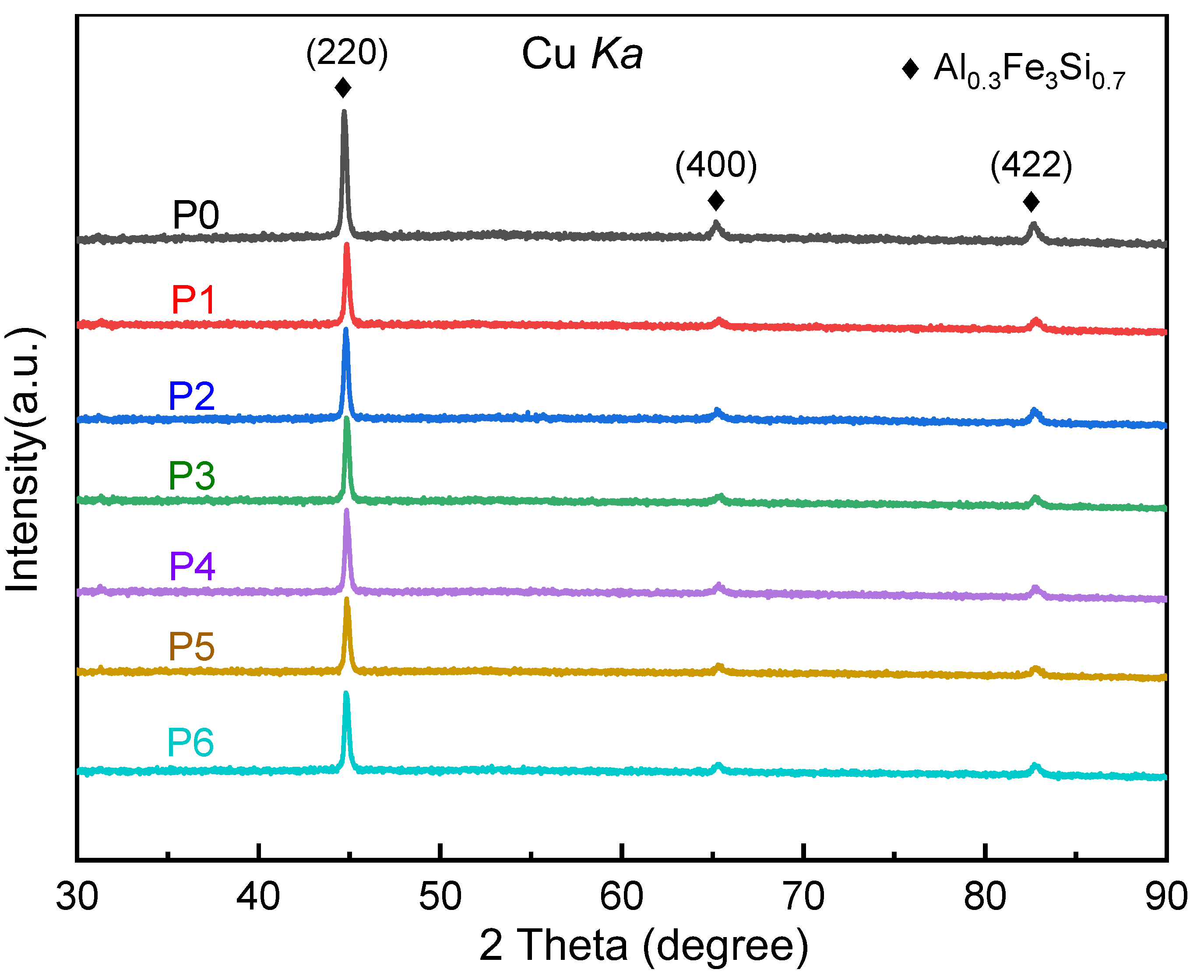
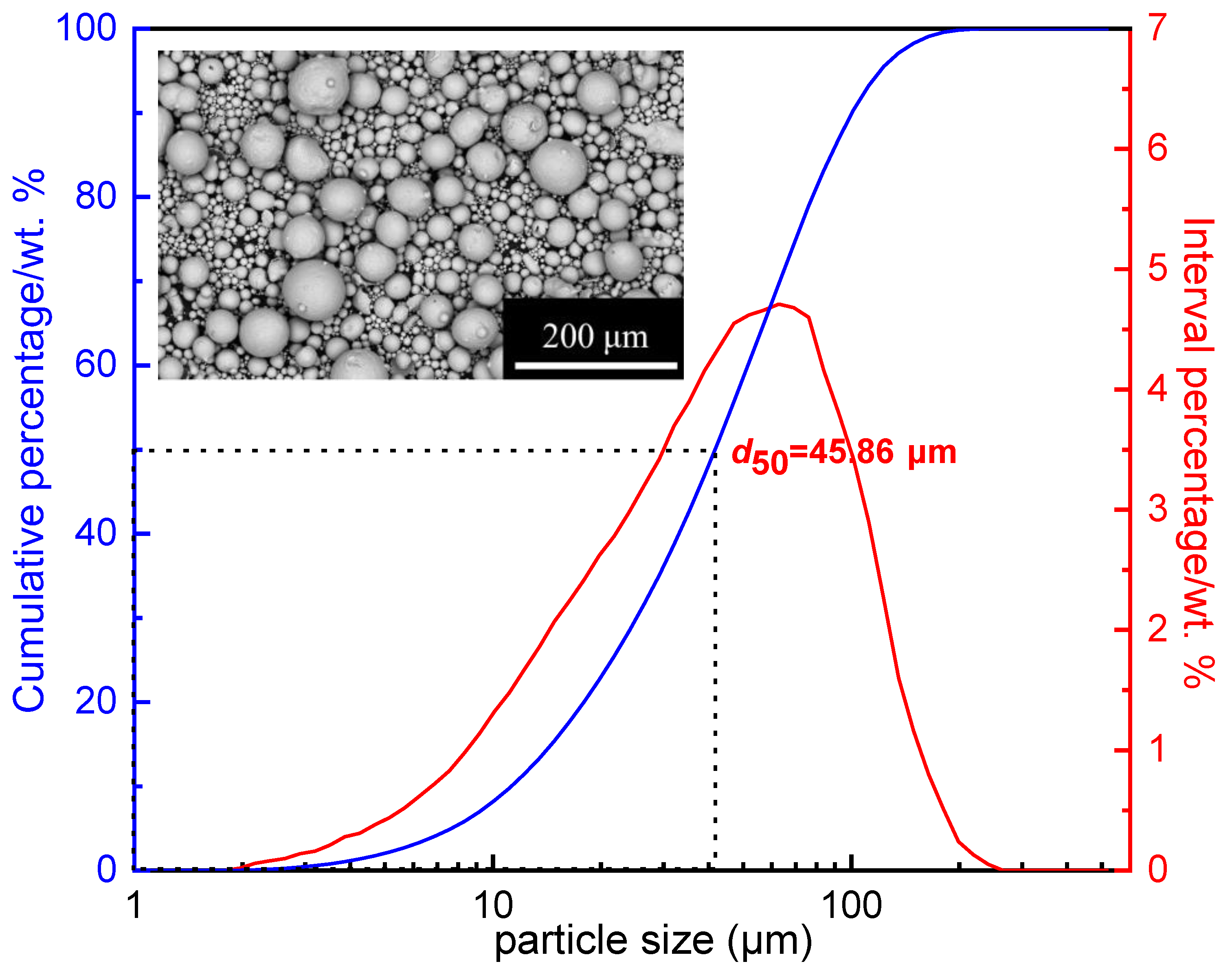

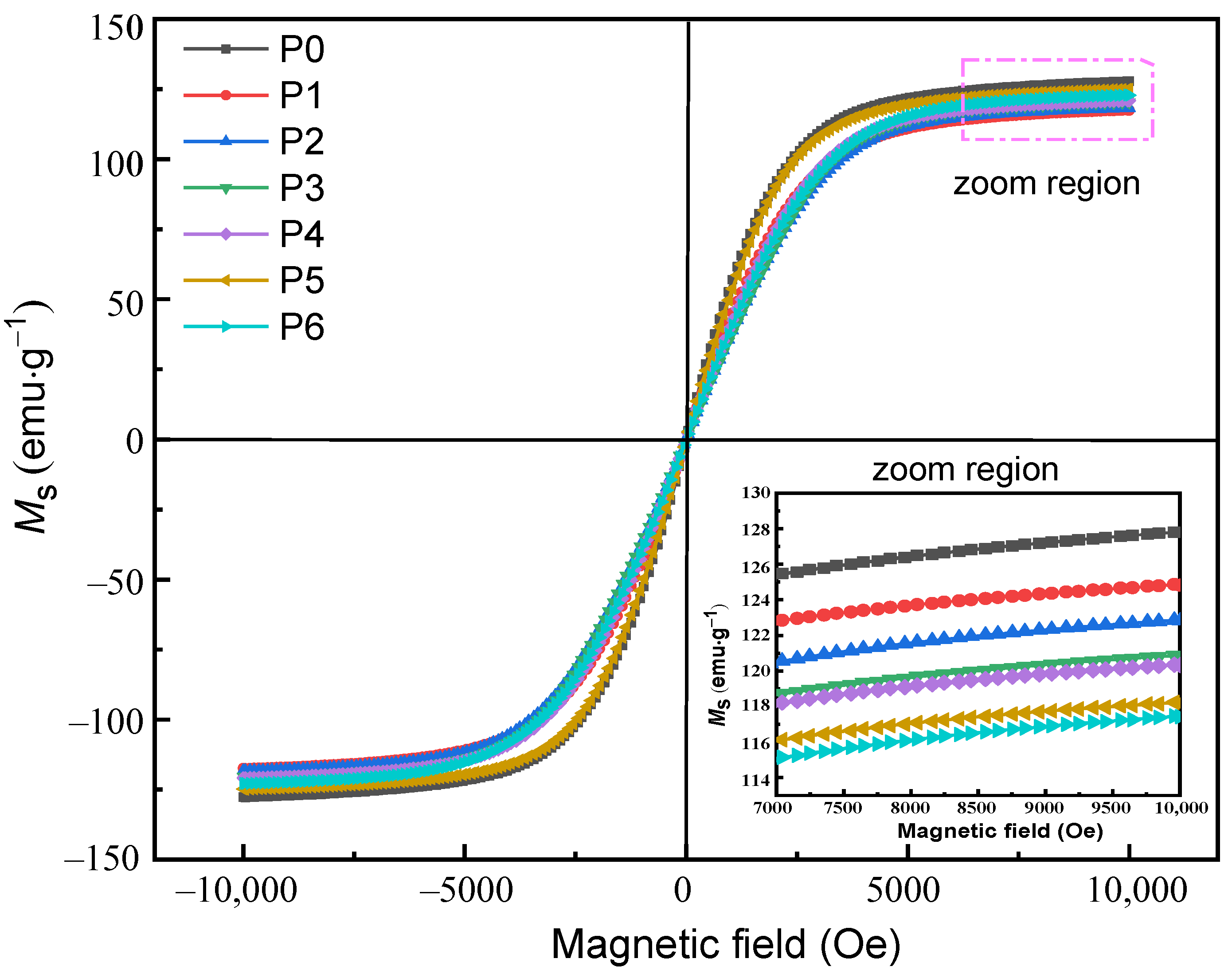
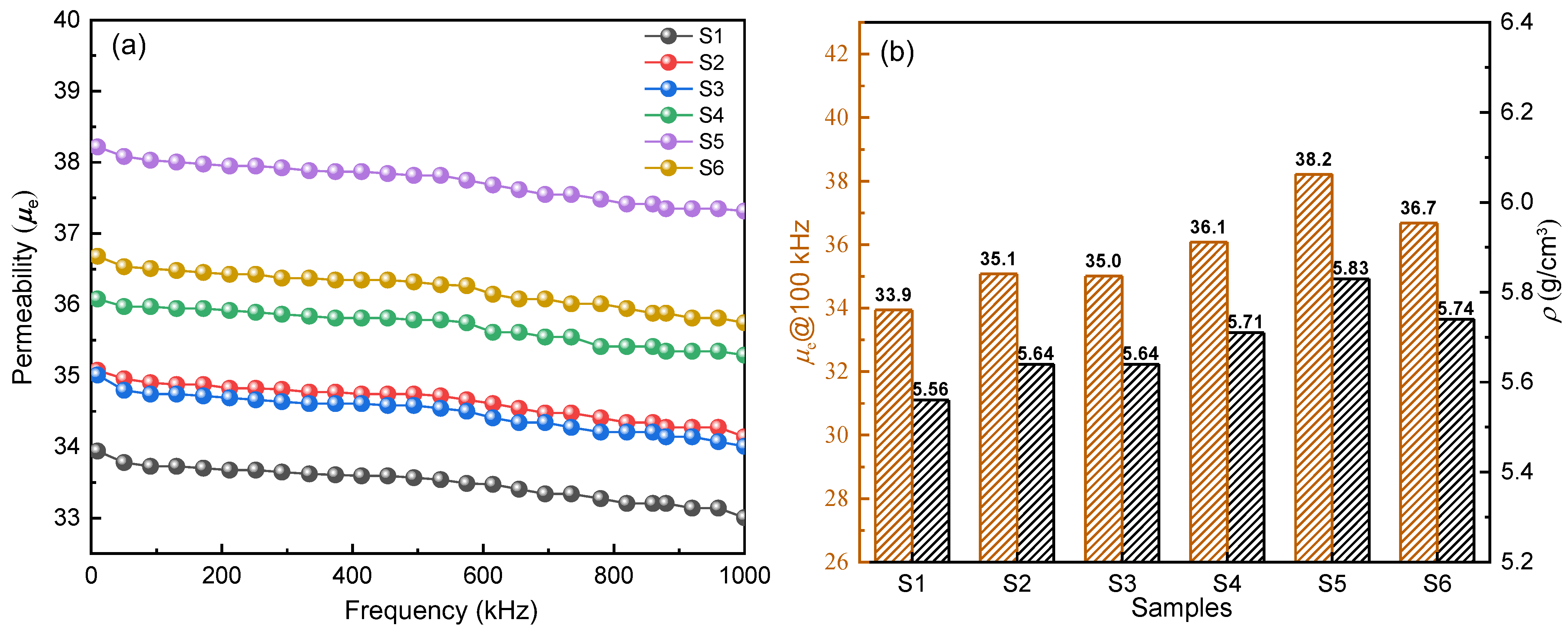
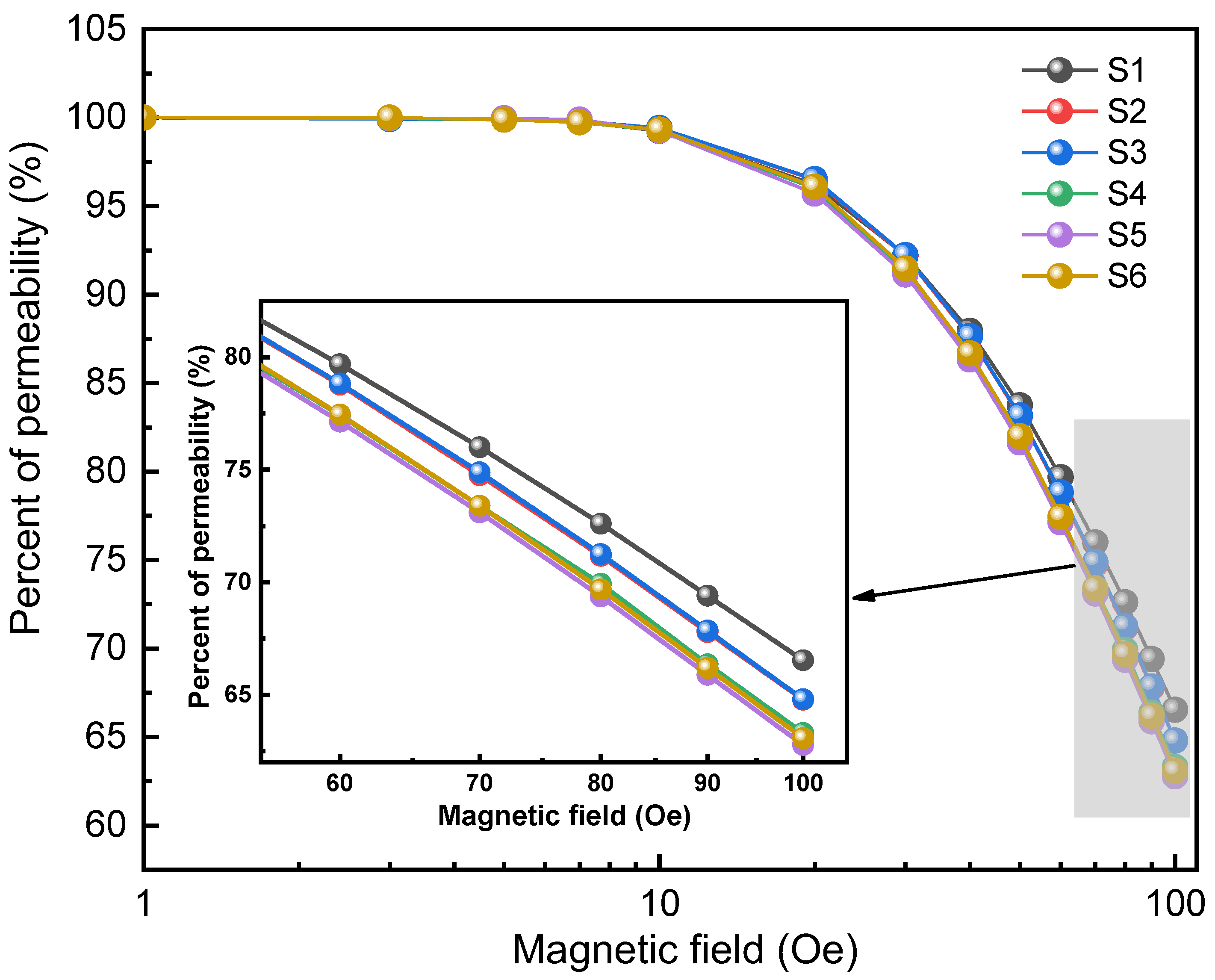

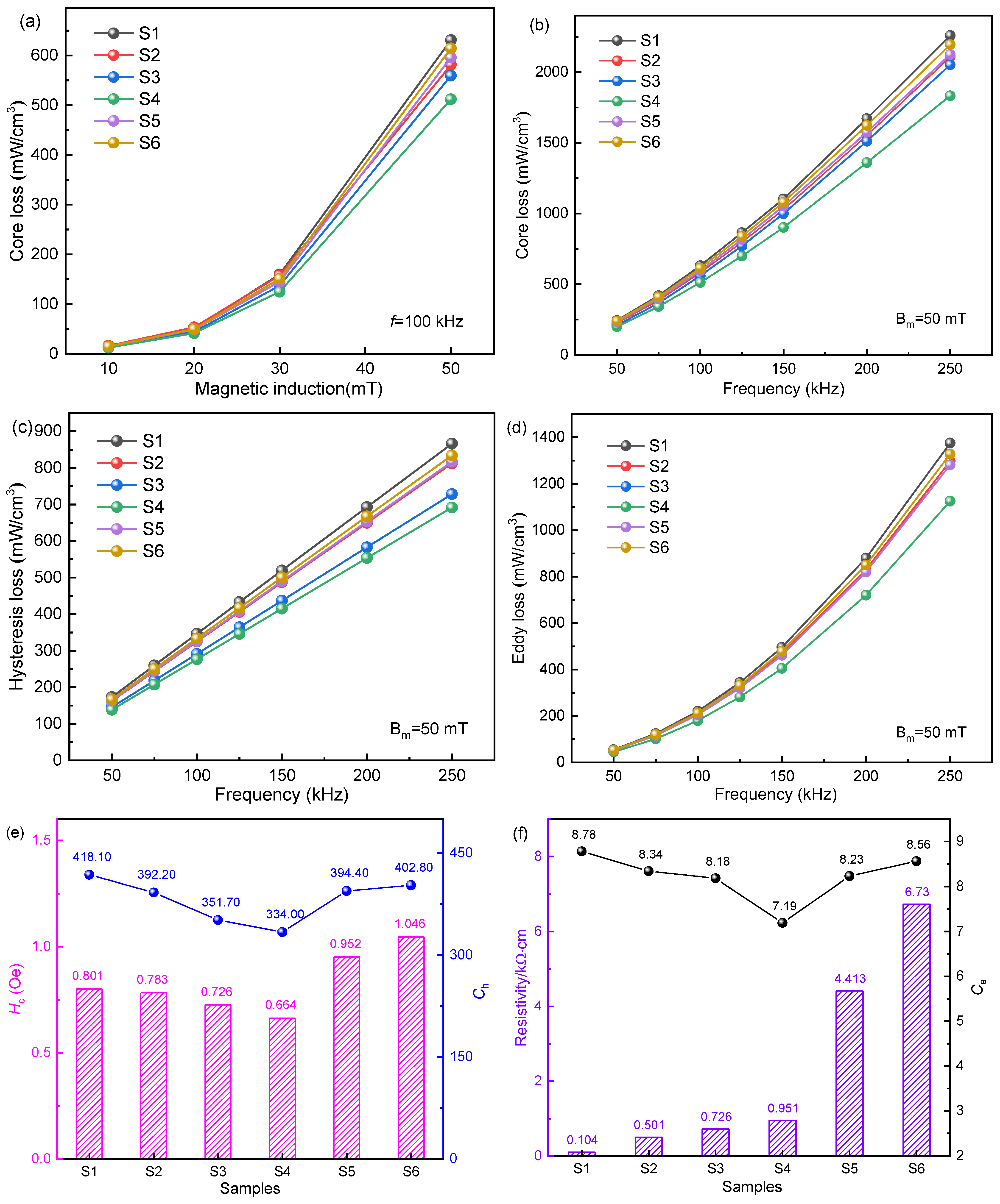
| Sample | Ms | ρ | μe | Core Loss, Pcv (mW·cm–3) | DC-Bias (%) | ||
|---|---|---|---|---|---|---|---|
| emu∙g−1 | g∙cm−3 | 100 kHz | 50 kHz/50 mT | 100 kHz/50 mT | 1 MHz/20 mT | 100 Oe | |
| S1 | 117.4 | 5.56 | 33.9 | 243.7 | 630.9 | 2110.3 | 66.5 |
| S2 | 118.2 | 5.64 | 35.1 | 224.9 | 581.1 | 2068.1 | 64.7 |
| S3 | 120.3 | 5.64 | 35.0 | 210.0 | 559.3 | 1985.8 | 64.8 |
| S4 | 120.8 | 5.71 | 36.1 | 199.3 | 512.0 | 1733.9 | 63.3 |
| S5 | 124.8 | 5.83 | 38.2 | 233.9 | 595.7 | 1972.5 | 62.7 |
| S6 | 122.8 | 5.74 | 36.7 | 239.7 | 614.4 | 2044.5 | 63.1 |
Disclaimer/Publisher’s Note: The statements, opinions and data contained in all publications are solely those of the individual author(s) and contributor(s) and not of MDPI and/or the editor(s). MDPI and/or the editor(s) disclaim responsibility for any injury to people or property resulting from any ideas, methods, instructions or products referred to in the content. |
© 2023 by the authors. Licensee MDPI, Basel, Switzerland. This article is an open access article distributed under the terms and conditions of the Creative Commons Attribution (CC BY) license (https://creativecommons.org/licenses/by/4.0/).
Share and Cite
Zhu, Z.; Liu, J.; Zhao, H.; Pang, J.; Wang, P.; Zhang, J. Study of the Soft Magnetic Properties of FeSiAl Magnetic Powder Cores by Compounding with Different Content of Epoxy Resin. Materials 2023, 16, 1270. https://doi.org/10.3390/ma16031270
Zhu Z, Liu J, Zhao H, Pang J, Wang P, Zhang J. Study of the Soft Magnetic Properties of FeSiAl Magnetic Powder Cores by Compounding with Different Content of Epoxy Resin. Materials. 2023; 16(3):1270. https://doi.org/10.3390/ma16031270
Chicago/Turabian StyleZhu, Zhengqu, Jiaqi Liu, Huan Zhao, Jing Pang, Pu Wang, and Jiaquan Zhang. 2023. "Study of the Soft Magnetic Properties of FeSiAl Magnetic Powder Cores by Compounding with Different Content of Epoxy Resin" Materials 16, no. 3: 1270. https://doi.org/10.3390/ma16031270
APA StyleZhu, Z., Liu, J., Zhao, H., Pang, J., Wang, P., & Zhang, J. (2023). Study of the Soft Magnetic Properties of FeSiAl Magnetic Powder Cores by Compounding with Different Content of Epoxy Resin. Materials, 16(3), 1270. https://doi.org/10.3390/ma16031270





